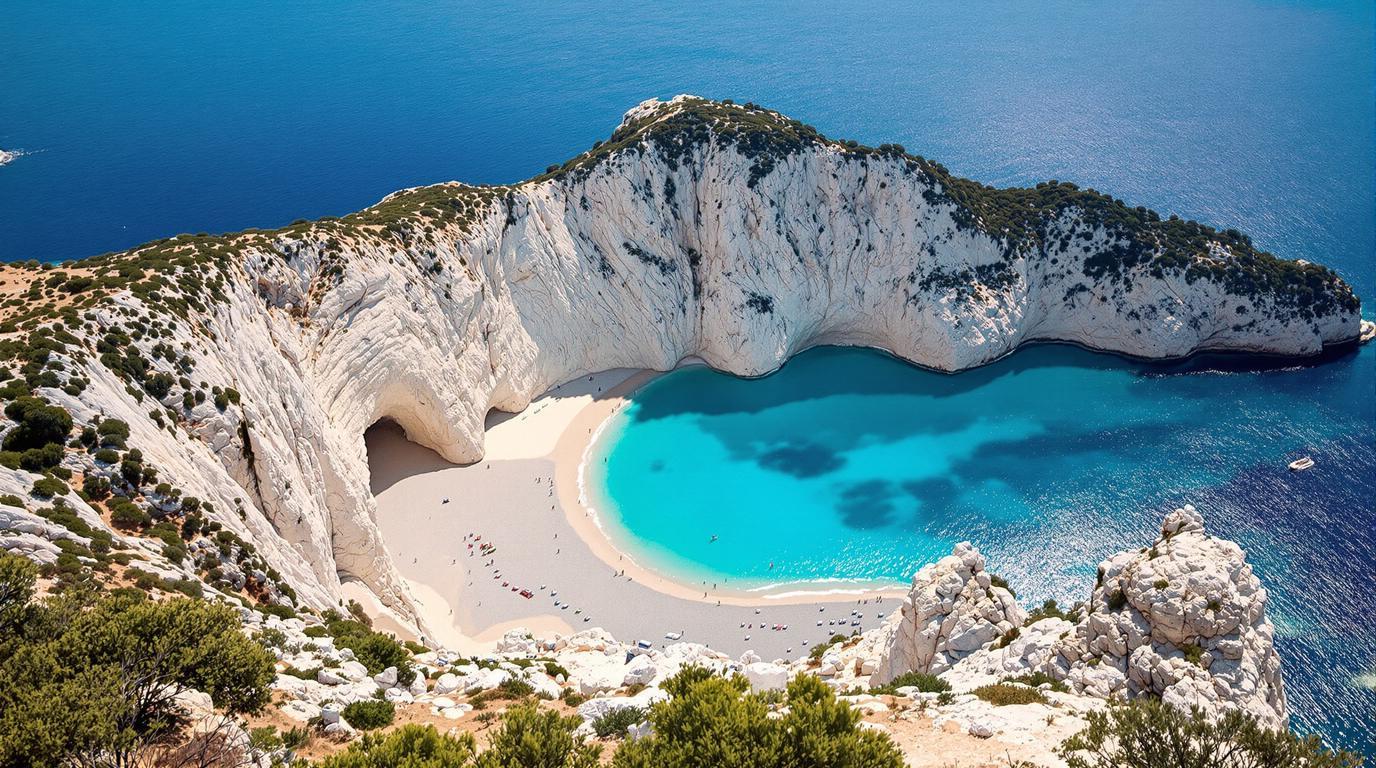Perched on the northwestern coast of Kefalonia in Greece’s stunning Ionian Islands, Myrtos Beach captures the imagination with its dramatic limestone cliffs plunging into impossibly blue waters. This 800-meter crescent of white pebbles isn’t just another Mediterranean paradise—it’s consistently ranked among Europe’s most photographed beaches, yet somehow maintains an air of untamed wildness that mass tourism hasn’t diminished.
A geological masterpiece shaped by millennia
Myrtos owes its breathtaking appearance to ancient geological forces. Positioned between two mountains—Agia Dynati and Kalon Oros—the beach’s dazzling white pebbles contrast dramatically with water that shifts from cobalt to turquoise throughout the day. These limestone cliffs, reaching nearly 300 meters high, create a natural amphitheater that frames the beach perfectly against the Ionian Sea.
The mysterious cave that tourists often miss
While most visitors focus on the main beach, adventurous travelers should explore the small cave on the left side of Myrtos. This hidden gem offers a memorable swimming experience that locals describe as a mini “Tunnel of Love.” The cave’s sheltered waters provide a tranquil escape from the sometimes rough conditions of the main beach, where currents can be deceptively strong.
Wild residents of the vertical cliffs
Look up from your beach towel and you might spot one of Kefalonia’s most nimble residents. Wild goats occasionally grace the seemingly vertical limestone faces surrounding Myrtos, providing an unexpected wildlife encounter. Their impressive climbing abilities and casual disregard for gravity add a touch of wilderness to this iconic beach setting.
“The first time you see Myrtos from the road above, it’s like someone painted the perfect beach. That view stops first-time visitors in their tracks every single time,” says Nikos, a local tour guide who has witnessed countless tourists gasp at their first glimpse.
The golden hour secret locals won’t tell you
While the beach attracts crowds during peak hours, savvy visitors arrive before 10:30 AM. This timing not only secures parking and sunbeds but also coincides with the magical morning light. As the sun climbs over the eastern cliffs, it transforms the water into a painter’s palette of blues that photographers dream about capturing. Similarly, other Greek islands offer equally magical mornings for those willing to rise early.
Adventure above the azure waters
For adrenaline seekers, paragliding off the towering cliffs provides an unparalleled perspective of Myrtos. Launching from above and gently descending to land on the beach below, paragliders experience the full dramatic contrast between mountains and sea. The aerial views rival even the most impressive aerial safaris elsewhere in the world.
The thermal phenomenon that transforms the water
Between May and September, Myrtos experiences a fascinating natural occurrence. The white pebbles absorb heat throughout the day, warming the shallow water to create temperature layers that enhance the vibrant blue hues. This natural warming effect makes swimming here distinctly different from other beaches, reminiscent of Turkey’s famous thermal terraces, though completely natural.
“The water at Myrtos has a quality I’ve never seen elsewhere. On calm days, it’s so clear you feel suspended in air rather than water. It’s why I return every summer,” explains Elena, a photographer who specializes in capturing Mediterranean seascapes.
Beyond the crowded summer months
While July and August see Myrtos at its busiest, May and September offer the sweet spot of perfect swimming temperatures with significantly fewer crowds. The shoulder season reveals a more contemplative side of this famous beach, allowing visitors to appreciate its natural beauty without competing for space—much like certain Caribbean islands that maintain their tranquility year-round.
When waves transform Myrtos into a spectacle
On windy days, swimming becomes challenging but photographers rejoice. The powerful waves crashing against the white shore create dramatic displays that rival the scenes from postcard-perfect days. Rather than disappointing, these conditions transform Myrtos into a different kind of natural wonder—one of raw power rather than serene beauty.
The road journey that rivals the destination
The winding approach to Myrtos Beach offers panoramic views that compete with the famous vistas of Bavaria’s fairy tale landscapes. Each hairpin turn reveals a new angle of the beach below, building anticipation until the final descent. Many visitors find themselves pulling over multiple times simply to absorb the changing perspectives.
As the sun begins its descent toward the horizon, Myrtos Beach transforms once again. The water deepens to indigo, the white pebbles glow with absorbed daylight, and the dramatic cliffs cast lengthening shadows. This isn’t just another beautiful beach—it’s nature’s perfect theater, where geology, light, and water perform an endless show that has captivated travelers since ancient times.
